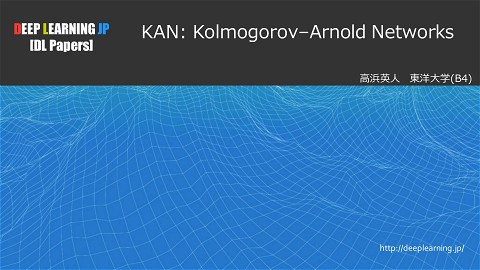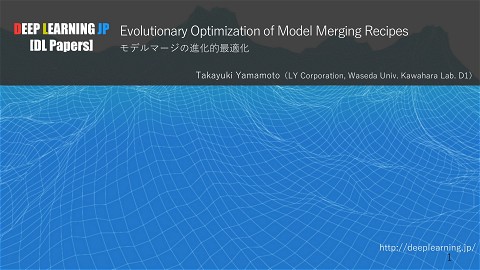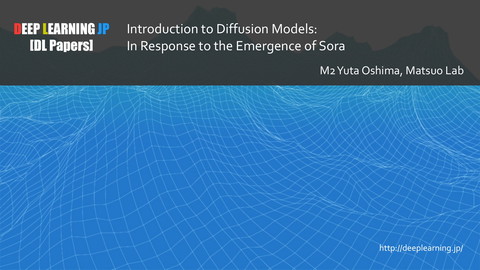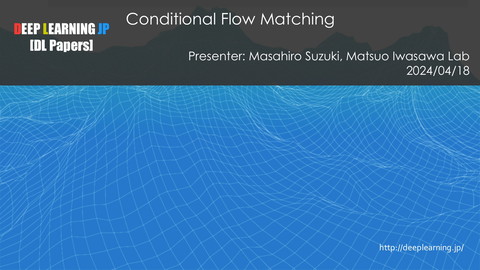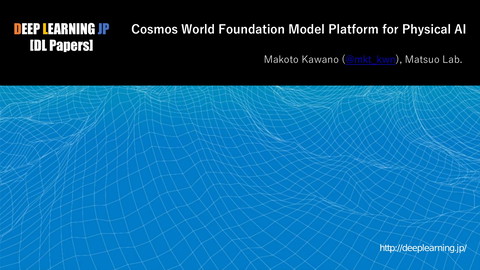【DL輪読会】HyperSeg: Towards Universal Visual Segmentation with Large Language Model
4.6K Views
February 13, 25
スライド概要
DL輪読会資料
関連スライド
各ページのテキスト
DEEP LEARNING JP [DL Papers] HyperSeg: Towards Universal Visual Segmentation with Large Language Model 国際航業(株) 林 http://deeplearning.jp/ 1
書誌情報 • タイトル:HyperSeg: Towards Universal Visual Segmentation with Large Language Model • 投稿先:arxiv(2024年11月末) • Code:https://github.com/congvvc/HyperSeg – 学習コードはまだ未公開(公開予定あり) • 選定理由: – マルチモーダル(特に言語と画像のフュージョン)に興味 – 様々がタスクに通用するネットワークで対応 – 様々なbenchmarkで高精度を示した
概要 • 様々なpromptに従った多種類のsegmentationタスクを1つのモデルで対応 – Visual Large Language Models (VLLMs)より、言語に関する知識を習得 – temporal adapterを提案し、時系列情報を理解して動画にも対応
本手法が対応するpromptの種類 • text prompts – class names, reasoning questions, referring languages • visual prompts – box, mask, pointなど
関連研究 • VLLM – 通常は画像のコンテンツを描写する文書を出力。画素レベルの認識に対応不可 – 代表的な手法:BLIP-2, Flamingo, MiniGPT-4, LLaVA, InstructBLIP , Qwen-VL等 • Perception with VLLM – bboxをpromptとして与えて、grounding能力を示した – mask decoderをつけることでsegmentationも可能 – PSALMが初めてVLLMを導入したが、VLLMの性能を十分に引き出せていない • Unified segmentation model – Mask2formerはunifiedネットワークで様々なsegmentationタスクに対応できるが、 タスク毎に学習する必要がある – OpenSeeDはtext encoderを追加し、Open-Set settingに対応。UNINEXT類似する 構造でreferring segmentationに対応。ただし、複雑な文書への対応が困難
提案手法のネットワーク概要 • ネットワーク構成:vision encoder, VLLM, segmentation predictor • 入力:vision-prompt pairs 𝒱, 𝒫 • 出力:入力promptに応じたsegmentation masks, class scores, instance embedding(動 画の場合)
Prompt design • モデルの入力:vision-prompt pairs 𝒱, 𝒫 • prompt 𝒫をtext / visual promptに分類 – 𝒫ℒ : どのようなタスク(instruction) – 𝒫𝒞 : 具体的なタスク条件 – visual promptは、その座標でCLIP visual特徴量からsampling 大項目 具体的なタスク prompt例 class-based segmentation • • • panoptic segmentation open-vocabulary segmentation (OVS) video instance segmentation (VIS) 𝒫ℒ : “Please segment all the positive objects according to the following potential categories.” 𝒫𝒞 : “[category 1, category 2, category 3, ...]” referring and reasoning segmentation • • • • referring expression segmentation (RES) 𝒫ℒ : “Can you perform referring or reasoning segmentation according reasoning segmentation to the language expression?” referring video object segmentation (R-VOS) 𝒫𝒞 : “[referring / reasoning text]” ReasonVOS visual-guided segmentation • • interactive segmentation video object segmentation (VOS) 𝒫ℒ : “Please segment according to the given visual region reference” 𝒫𝒞 : “[vision 1, vision 2, vision 3, ...]”.
Vision Encoder • 従来手法は、CLIPのvisual encoderの特徴のみ利用することが多い – 課題:粒度が高いsegmentationタスクに対して情報が不十分 • Fine-grained Visual Perceiver(FVP)を提案し、粒度の高いvisual情報を 抽出(VLLMの入力とする) – pyramid vision encoderにより異なるスケールの特徴を抽出 (𝑖) – 各スケール特徴𝑓𝑖𝑚𝑔 とfined-grained token 𝑃𝑗 を条件付き重み付きcross-attentionに より、情報を集約
Visual Large Language Model • VLLMは既存モデルを利用 – visual encoder(CLIP)と軽量化のLLMで構成 • LLMの入力: – vision token 𝑓𝑣 : CLIP encoderの出力から取得(画像全体のvisual情報) – fined-grained token 𝑃: FVPの出力 – prompt token 𝒫 • LLMの出力 – prompt embedding – semantic recognition – mask tokens – fine-grained tokens segmentation predictorに入力
Hybrid Entity Recognition • LLMを介したsegmentationは3つの流派 ① クラスとマスクをLLMが生成:漏れや誤検出が多い傾向 ② クラスとマスクをmask decoderが推定(LLMがprompt tokenをembedする役 割):LLMの強力なセマンティックな能力を活かさず ③ 本論文はハイブリッドな方式を提案:prompt embeddingをdecodeする。入力画 像にあるすべての物体のクラスとそのmask tokenを別々で生成 • mask tokenと対応するsemantic情報を取得
Segmentation predictor • 基本構造は、Mask2Formerを採用 – 3つの入力でmaskと分類scoreを推定 𝐾 • task-specific prompt embedding 𝐸𝒫𝑘 𝑘=1 , 𝐾 =カテゴリー数 • semantically enhanced mask tokens 𝑗 𝑁 𝐸𝒬 , 𝑁 =mask推定個数 𝑗=1 • multi-scale visual features 𝑓𝑖𝑚𝑔 – 動画を扱う場合、instance embedding 𝑒を推定 • 動画は、フレーム毎にsegmentationを実施
Temporal Adapter • 動画を処理する場合、フレーム間の整合性をとる必要がある • 本論文は、global prompt aggregationとlocal space-time information injectionを提案 – 前の全フレームのprompt embeddingをpooling – 前の1枚フレームのfine-grained tokenから更新
学習目的関数 • 各タスクに共通するloss関数で学習 – ℒ𝑡𝑒𝑥𝑡 : autoregressive cross-entropy loss for text prediction • 論文中詳細は言及せず。Supplementaryの情報から、image captionやVQAのようなタスクで visual-languageの理解を保持(?) – ℒ𝑚𝑎𝑠𝑘 : mask推定loss – ℒ𝑐𝑙𝑠 : カテゴリー分類cross entropy loss – ℒ𝑖𝑛𝑠 : contrastive loss for instance association(動画の場合)
実験設定 • 合計10個のタスクを同時に学習 – 各タスクは約16k iterationを学習 – VLLMはMipha3Bを採用。LLM部分の学習はLoRA採用 • LLMはPhi-2-2.7Bを採用。Visual encoderはSigLIPを採用 – Segmentation predictorはMask2Formerを採用 – 8 NVIDIA A100 GPUsで学習(batch size=32)
実験結果- Referring expression segmentation • RefCOCO/+/gにおいて、SOTAを達成 • 更に難しいgeneralized referring expression segmentationでも有効 – Zero-shot形式で評価
実験結果-Reasoning segmentation • 動画と画像ドメインにおいて、SOTAを達成
実験結果-Generic image segmentation • closed-set and open-vocabulary segmentation両方に効果を確認
実験結果-Common video segmentation • 具体的には、visual-prompted semi-supervised VOS (DAVIS17), textprompted referring video object segmentation (Ref-YouTube-VOS, RefDAVIS17), video instance segmentation (YouTube-VIS 2019)で評価
実験結果-Ablations • 複数タスクの同時に学習することで、モデル性能を向上 – 特に動画segmentationタスクにおいて、画像segmentationも学習する効果が大きい • 提案手法は別のLLMでも効果を発揮
実験結果-Ablations • 提案のFVPとHERの有効性を確認 • 動画に対し、global prompt aggregation(全フレーム情報のpooling)と local space-time information injection(前1フレームの情報を更新)の効 果を確認
まとめ • VLLMを利用し、様々なsegmentationタスクを一つのモデルで対応でき る手法を提案 – 異なるスケールのvisual情報を利用 – VLLMの出力形式に工夫 – 画像と動画両方に対応可能。特に画像関連の複数タスクでは、SOTAを達成 • 所感 – 既存のモデルをうまく組み合わせて、様々なタスクを一つ比較的に小さいモデ ルで対応 – Mask2Formerの形に合わせてLLMを組み合わせた気もしなくない

